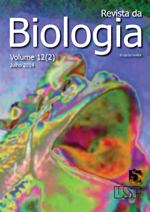O Relógio Biológico e os ritmos circadianos de mamíferos: uma contextualização histórica
DOI:
https://doi.org/10.7594/revbio.12.02.01Palavras-chave:
Ritmo circadiano, Oscilador, Núcleos supraquiasmáticos, Genes do relógio.Resumo
O termo “relógio biológico” se refere ao conjunto de mecanismos endógenos capazes de conferir ritmicidade a processos fisiológicos e comportamentais do organismo independentemente das pistas ambientais externas. As estruturas responsáveis por gerar esta ritmicidade são denominadas “osciladores” e sua capacidade oscilatória circadiana é decorrente da expressão rítmica de certas proteínas ao longo do dia, codificadas pelos “genes do relógio”. Nos mamíferos, o oscilador central é composto pelos núcleos supraquiasmáticos (NSQs), os quais são capazes de sincronizar o ritmo das outras células do corpo e os osciladores periféricos ao ciclo claro/escuro ambiental, permitindo que o organismo seja capaz de prever as variações externas circadianas. Fatores genéticos ou ambientais que prejudiquem esta sincronia podem causar diversos distúrbios fisiológicos, inclusive algumas formas de câncer.Downloads
Os dados de download ainda não estão disponíveis.
Downloads
Publicado
2018-04-23
Edição
Seção
Revisão
Licença
Salientamos que nossa revista não detém copyright, estes são exclusivos do autor do texto. Pretendemos com isso não criar entraves ao acesso do material publicado e atingir com mais intensidade nosso objetivo de divulgação da ciência.
Como Citar
Lima, L. E. B., & Vargas, N. N. G. (2018). O Relógio Biológico e os ritmos circadianos de mamíferos: uma contextualização histórica. Revista Da Biologia, 12(2), 1-7. https://doi.org/10.7594/revbio.12.02.01








 revistadabiologia@ib.usp.br
revistadabiologia@ib.usp.br 2008 - 2024 Revista da Biologia
2008 - 2024 Revista da Biologia